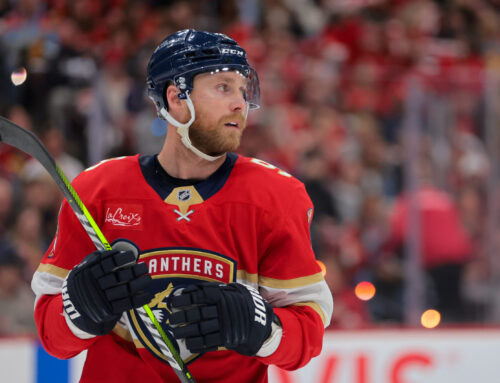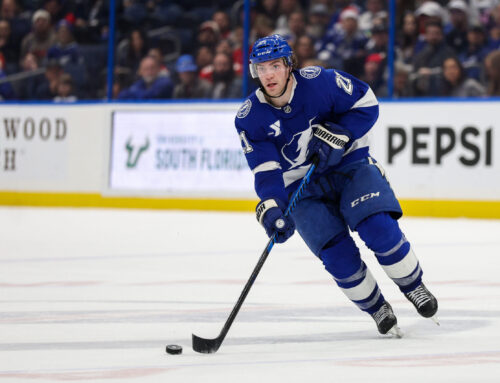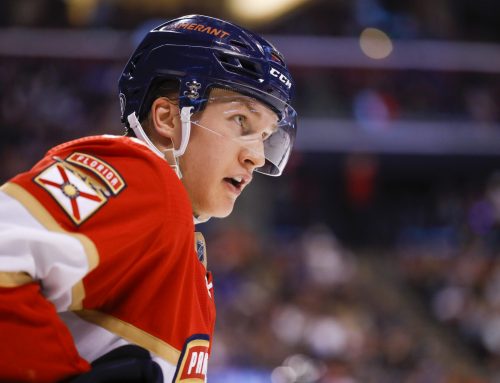
Although multi-positional eligibility is often considered a benefit by poolies due to line-up flexibility, it can sometimes create fantasy headaches as well. This week’s combatants – Brayden Point and Sam Reinhart – are C and RW eligible in most leagues; but that versatility has led their teams to bounce them between each of their top three lines during their brief careers. Given this uncertainty, who figures to be the better own for 2017-18, and long term? Let’s find out – Cage Match starts now!
Career Path and Contract Status
Point, 21, was selected 79th in 2014 on the heels of a 91 point WHL campaign. He returned to the WHL for two more seasons – with a brief AHL stop in between (four points in nine games) – culminating in 88 WHL points in just 40 games in 2015-16. That earned him a long look in Tampa’s 2016 training camp, and he somewhat surprisingly made the team. After 17 games, he stood at just five points; but the injury to Steven Stamkos solidified a spot for Point, and from there he not only showed he could score but got better as the season went on, with 21 of his 40 total points coming in his final 30 contests.
Reinhart, 21, was also drafted in 2014, but 72 picks earlier at #2 overall after a stellar WHL career. That same season he had a nine-game NHL cameo (scoring one point), then spent more of the year back in the WHL. Starting in 2015-16 he was with the Sabres for good, posting 42 points that season and improving to 47 in 2017-18, during which he showed consistency by posting either eight or nine points per month from November through March.
Both players are on ELCs. Point is a better bargain, counting $0.686M against the cap this season and next, while Reinhart dings the cap at $0.894M for 2017-18 before becoming an RFA this summer.
Ice Time
|
Season |
Total Ice Time per game (rank among team’s forwards) |
PP Ice Time per game (rank among team’s forwards) |
SH Ice Time per game (rank among team’s forwards) |
|
2016-17 |
17:07 (B.P.) – 8th 17:13 (S.R.) – 5th |
2:31 (B.P.) – 6th 2:55 (S.R.) – 3rd |
0:16 (B.P.) – 14th 0:03 (S.R.) – 12th (tied) |
|
2015-16 |
16:50 (S.R.) – 5th |
2:56 (S.R.) – 3rd |
0:01 (S.R.) – 12th |
Reinhart’s PP Time jumps out, and sure enough over the past two seasons only 27 other forwards had more combined PP TOI. Yet his 89 total points for 2015-16 and 2016-17 were well worse than any of the 27. In fact, aside from Patrick Marleau (94 points), Henrik Sedin and Daniel Sedin (105 for both), each of the other 24 had 114+ combined points, or at least 17% more than Reinhart.
Blame for this can’t be placed entirely on Buffalo as a team. Yes, they stood fourth worst in combined goals scored in 2015-16/2016-17 with 398; but that meant Reinhart had point on only 22% of his team’s goals, which is low. Even if Buffalo had scored 17% more goals over the last two seasons – for a total of 465 – and Reinhart had maintained his 22% rate of points on team goals, that still would have translated to only 103 points for Reinhart, keeping him below all but Marleau. Not good.
Point’s TOI numbers were surprisingly – at least to me – similar to those of Reinhart. And if we do the math, their 82 game scoring paces were identical too –48 points. So who performed better?
In favor of Point is that he played less with his team’s top forward, as despite Jack Eichel appearing in only 61 games, Reinhart still shared the ice with him for more than 50% of all shifts Reinhart played over the course of 2016-17, while, Point skated with Nikita Kucherov for under 30% of his total shifts. On the other hand, a case could be made that Reinhart elevated Eichel’s play, and Point made Kucherov worse. That’s because Buffalo’s goals per 60 minutes rate when Eichel and Reinhart shared together was 2.52, whereas its rate when Reinhart skated without Eichel was 2.80 and Eichel’s rate without Reinhart was only 2.20, while when Point and Kucherov shared the ice Tampa’s rate was 3.31, but its rate when Point played apart from Kucherov was nearly a full goal lower (2.37) and Kucherov’s without Point was 3.63.
Another factor was Tampa outscored Buffalo last season by 41 goals (230 vs. 199), so one could assert Point was more “along for the ride” when it came to scoring. But then again, Reinhart, by being a top six player at ES, and a PP1 staple, arguably bears more blame for his team’s shortcomings. Overall, there’s an unclear picture about both thus far.
Secondary Categories
|
Season |
PIMs (per game) |
Hits (per game) |
Blocked Shots (per game) |
Shots (per game) |
PP Points (per game) |
|
0.20 (B.P.) 0.10 (S.R.) |
0.57 (B.P.) 0.26 (S.R.) |
0.45 (B.P.) 0.50 (S.R.) |
1.79 (B.P.) 2.22 (S.R.) |
0.17 (B.P.) 0.21 (S.R.) |
|
|
2015-16 |
0.12 (S.R.) |
0.33 (S.R.)
📢 advertisement:
|
0.33 (S.R.) |
2.09 (S.R.) |
0.14 (S.R.) |
Reinhart’s increased year-to-year scoring from came via PPPts, as he had 17 last season versus 11 in 2015-16. He also averaged over two SOG per game in both seasons, joining eight other forwards since 2000-01 who, also by age 21, had 2+ seasons of 47 points or less scoring despite averaging 2+ SOG per game in each of those seasons. A couple (Elias Lindholm, Dylan Larkin) are too young to make for meaningful comparison as yet, while among the other six more went on to do great things (Phil Kessel, Marian Gaborik) or to have solid fantasy careers (Scott Hartnell, James van Riemsdyk) than former top ten picks who didn’t ultimately fulfill lofty expectations (Sam Gagner, Michael Frolik). Although of course circumstances (e.g., teams, ice times, linemates, etc.) differed for these players than for Reinhart, this data is at least somewhat reassuring overall.
Point is the better all-around contributor, but nothing here is particularly impressive either alone or in the aggregate. In other words, he doesn’t appear to contribute – physically or offensively – in ways that couldn’t be replicated by other forwards. That’s not ideal, especially when playing for a team with as much deep current (and prospect) talent among its forward ranks as Tampa. Then again, the fact that he’s able to command playing time despite not shining in any one area perhaps reinforces the team’s commitment to him.
Luck-Based Metrics
|
Season |
Personal Shooting % |
Team Shooting % (5×5) |
Individual Points % (IPP) |
Offensive Zone Starting % (5×5) |
Average Shot Distance |
Secondary Assists % |
|
2016-17 |
14.8% (B.P.) 9.6% (S.R.) |
8.83 (B.P.) 6.98 (S.R.) |
54.1% (B.P.) 55.3% (S.R.) |
58.2% (B.P.) 51.3% (S.R.) |
23.6 (B.P.) 27.5 (S.R.) |
63% (B.P.) 23% (S.R.) |
|
2015-16 |
13.9% (S.R.) |
7.01 (S.R.) |
56.0% (S.R.) |
51.7% (S.R.) |
21.3 (S.R.) |
31% (S.R.) |
Although we only have a season’s worth of numbers to assess for Point, there’s good and bad. and not much in between. Although his personal shooting % was likely too high to be sustainable, his team shooting % was a shade below the 9.0% number considered average for NHL forwards. Therefore, while he might’ve had more goals that he should’ve, his overall scoring likely wasn’t out of line. Beyond that, his secondary assists % was troublingly high, since the only forward last season with more secondary assists but not more primary assists was the aging Justin Williams.
Yet at the same time, Point’s ASD was 23.6, which helps mitigate against his lower shot rate. Still, shots create scoring, so it could be that he’s too selective with his shooting. Lastly, there’s his IPP, which is so low as to cause concern he’s not a player who finds a way onto the score sheet; but at the same time, it’s just one season of data and seemingly has nowhere to go but up, which, if that was to occur, would boost his production without there even needing to be more goals scored.
For Reinhart, one would think his low secondary assists rate would automatically bode very well for him; but looking at the comparable data doesn’t provide a clear indication of that being the case. Although Jeff Skinner, a two-time 63 point scorer, is the only forward other than Reinhart to have 36+ combined primary assists but 15 or fewer secondary assists over the past two seasons, if we look at players who had 36+ primary assists and 20 or fewer secondary assists over the past two combined seasons, we see a nearly even mix of older players on the decline (Daniel Sedin, Thomas Vanek, Corey Perry, Milan Lucic) and peak or pre-peak players who might still be getting better (Nino Niederreiter, Cam Atkinson, Max Domi, Mikael Granlund, and Elias Lindholm).
Reinhart’s team shooting percentage was predictably low in 2015-16 when Buffalo struggled mightily; and although it didn’t improve last season despite the team making strides, he was not alone in that regard, as Eichel saw his number only increase by a tad (7.21 to 7.3) and Ryan O’Reilly saw his decline (from 7.1 to 6.67). Reinhart also had a low ASD, which is more impressive given him firing over 2 SOG per game in both seasons and should normally bode well for future goal totals.
One area where it’s hard to find a silver lining for Reinhart, however, is IPP. Readers of this column know that 70% seems to be the IPP threshold which forwards need to surpass to be (or to become) high scorers, so to see Reinhart fall so far below that level not once but twice, and by so much, is not a good sign for him or poolies who own him.
Early Results for 2017-18
Point emerged red hot, but had cooled with just one point in his next five games before a two-point effort on Saturday put him back above the point per game threshold. And that’s despite spending the vast majority of his shifts outside of the top six and not on PP1. But before we get too excited, his offensive zone starting % is below 45% and his IPP a staggering 91%, strongly suggesting his early production is unsustainable. Still – even if there is some correction, it’s quite plausible he should stay on course to best his scoring rate from 2016-17.
Reinhart stands at three points in nine games, with all three coming in his last four contests. But we shouldn’t let this recent momentum cloud what looks to have the makings of a poor season – one that could see Reinhart’s production decline from 2016-17. After all, his OZ% is 45%, his shot rate is way down (11 in nine games), and his IPP is still 40%, which amazingly isn’t too much lower than his modest rates in his two prior seasons. Perhaps the only silver lining is he’s yet to spend any meaningful time at wing with Eichel; but Eichel is doing fine without Reinhart, so poolies can’t hold their breath for those two to be reunited any time soon.
Who Wins?
On the one hand, there were a number of 2016-17 red flags for Point, and his torrid start to 2017-18 is not remotely sustainable; however, as I’ve learned in writing this column, there are players who defy draft position and “fancy stats” and just go out and find and way to succeed on whichever line and with whomever they skate. More and more he seems to be one of those types of players.
For Reinhart, what concerns me is the number of comparables where his output/patterns were similar to (or even worse than) those of aging players. And it wasn’t for lack of opportunity over these past two seasons, nor can it be blamed on a subpar team. Beyond that, he’s a natural center stuck behind one of the arguably best young #1 centers in Jack Eichel, and a minute-eating two-way pivot in Ryan O’Reilly, who both are inked through 2023. While there’s still a chance he could be repackaged as a top six winger on a going forward basis, especially if Evander Kane isn’t re-signed, who’s to say that will lead to him doing well, since it didn’t in 2015-16 and 2016-17? Another possibility is they trade him (as floated last week by Elliotte Friedman), and perhaps that could present him with a chance to play his natural position in the top six on a regular basis,
In the end, there are more ifs and worry signs surrounding Reinhart; and in fantasy, ifs are not your friend, so Point wins this match. Although his early pace is unsustainable, it’s still best to hold Point for now, as you won’t be able to get close to true value and he should still push 60 points. As for Reinhart, you could try to sell, but don’t expect much in return as the shine of his #2 overall draft spot has already faded. Perhaps you can try to land another player who’s seen as a disappointment by poolies but who might have a somewhat better path to likely success than Reinhart? Either that, or hold and hope.





 CHI
CHI BUF
BUF NYR
NYR TOR
TOR ANA
ANA PIT
PIT N.J
N.J L.A
L.A DET
DET CAR
CAR BOS
BOS
